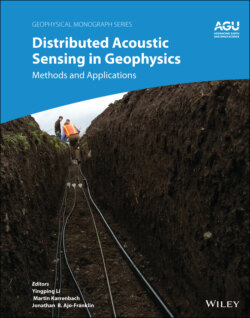Читать книгу Distributed Acoustic Sensing in Geophysics - Группа авторов - Страница 74
4.4. FIELD TRIAL OF NEAR‐SURFACE SEISMIC EXPERIMENT WITH PGC‐DAS SYSTEM
ОглавлениеA near‐surface seismic experiment based on fiber optic cables and PGC‐DAS system was conducted in Hebei Province, China. On the site, a 7 mm diameter fiber optic cable (Figure 4.7d) of about 430 m was buried in an approximate L shape at 0.4 m depth with a 230 m cable in Line 1 and a 200 m cable in Line 2 (Figures 4.7a and 4.7b). PGC‐DAS system was connected at one end of the fiber optic cable to record multichannel seismic data at a sampling rate of 2 kHz with a spatial sampling interval of 1 m. For comparison, 80 conventional three‐component (3C) geophones (Figure 4.7c) were buried along the cable with an interval of around 5 m. A vibroseis truck was employed as an active source at seven designed positions (P1, P2, P3, P4, P5, P6, and P7) around the fiber optic cable to investigate directivity, since optical fiber is mostly sensitive to axial strain along the fiber and lacks broadside sensitivity due to its silica glass nature.
Figure 4.8 shows multichannel seismic recordings of PGC‐DAS system and geophone array in Line 1 at active source position #1. Since axial is the most sensitive direction of the fiber, the data of a 3C geophone for x‐component were used. Both 40 channels’ recordings for DAS system and geophones’ array with the same interval of 5 m at similar positions were selected. Difference of seismic first arrivals’ time between those two systems is due to trigger unsynchronization. DAS data were qualitatively similar to the signals observed on the geophones. Both direct wave and surface were clearly presented. However, there was apparently isolated noise in DAS data before the first arrivals (e.g., in Channels of 11, 151, and 161) due to interference fading. Simple contrast shows that this PGC‐DAS system can provide reliable information to image and explore the shallow subsurface under this fiber cable.
